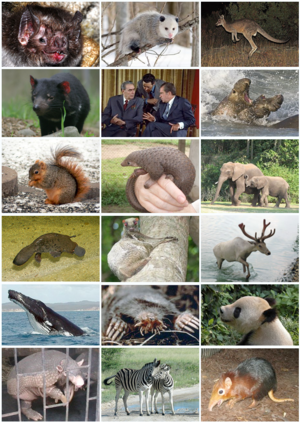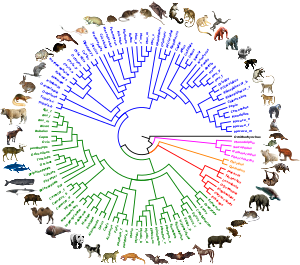
A | B | C | D | E | F | G | H | CH | I | J | K | L | M | N | O | P | Q | R | S | T | U | V | W | X | Y | Z | 0 | 1 | 2 | 3 | 4 | 5 | 6 | 7 | 8 | 9
| Mammals Temporal range:
| |
|---|---|
 | |
| Scientific classification | |
| Domain: | Eukaryota |
| Kingdom: | Animalia |
| Phylum: | Chordata |
| Clade: | Amniota |
| Clade: | Synapsida |
| Clade: | Mammaliaformes |
| Class: | Mammalia Linnaeus, 1758 |
| Living subgroups | |
A mammal (from Latin mamma 'breast')[1] is a vertebrate animal of the class Mammalia (/məˈmeɪli.ə/). Mammals are characterized by the presence of milk-producing mammary glands for feeding their young, a neocortex region of the brain, fur or hair, and three middle ear bones. These characteristics distinguish them from reptiles and birds, from which their ancestors diverged in the Carboniferous Period over 300 million years ago. Around 6,400 extant species of mammals have been described and divided into 29 orders.
The largest orders of mammals, by number of species, are the rodents, bats, and Eulipotyphla (including hedgehogs, moles and shrews). The next three are the primates (including humans, monkeys and lemurs), the even-toed ungulates (including pigs, camels, and whales), and the Carnivora (including cats, dogs, and seals).
Mammals are the only living members of Synapsida; this clade, together with Sauropsida (reptiles and birds), constitutes the larger Amniota clade. Early synapsids are referred to as "pelycosaurs". The more advanced therapsids became dominant during the Middle Permian. Mammals originated from cynodonts, an advanced group of therapsids, during the Late Triassic to Early Jurassic. Mammals achieved their modern diversity in the Paleogene and Neogene periods of the Cenozoic era, after the extinction of non-avian dinosaurs, and have been the dominant terrestrial animal group from 66 million years ago to the present.
The basic mammalian body type is quadruped, and most mammals use their four extremities for terrestrial locomotion; but in some, the extremities are adapted for life at sea, in the air, in trees, underground, or on two legs. Mammals range in size from the 30–40 mm (1.2–1.6 in) bumblebee bat to the 30 m (98 ft) blue whale—possibly the largest animal to have ever lived. Maximum lifespan varies from two years for the shrew to 211 years for the bowhead whale. All modern mammals give birth to live young, except the five species of monotremes, which are egg-laying mammals. The most species-rich group of mammals, the infraclass called placentals, have a placenta, which enables the feeding of the fetus during gestation.
Most mammals are intelligent, with some possessing large brains, self-awareness, and tool use. Mammals can communicate and vocalize in several ways, including the production of ultrasound, scent-marking, alarm signals, singing, echolocation; and, in the case of humans, complex language. Mammals can organize themselves into fission–fusion societies, harems, and hierarchies—but can also be solitary and territorial. Most mammals are polygynous, but some can be monogamous or polyandrous.
Domestication of many types of mammals by humans played a major role in the Neolithic Revolution, and resulted in farming replacing hunting and gathering as the primary source of food for humans. This led to a major restructuring of human societies from nomadic to sedentary, with more co-operation among larger and larger groups, and ultimately the development of the first civilizations. Domesticated mammals provided, and continue to provide, power for transport and agriculture, as well as food (meat and dairy products), fur, and leather. Mammals are also hunted and raced for sport, kept as pets and working animals of various types, and are used as model organisms in science. Mammals have been depicted in art since Paleolithic times, and appear in literature, film, mythology, and religion. Decline in numbers and extinction of many mammals is primarily driven by human poaching and habitat destruction, primarily deforestation.
Classification

Mammal classification has been through several revisions since Carl Linnaeus initially defined the class, and at present, no classification system is universally accepted. McKenna & Bell (1997) and Wilson & Reeder (2005) provide useful recent compendiums.[2] Simpson (1945)[3] provides systematics of mammal origins and relationships that had been taught universally until the end of the 20th century. However, since 1945, a large amount of new and more detailed information has gradually been found: The paleontological record has been recalibrated, and the intervening years have seen much debate and progress concerning the theoretical underpinnings of systematization itself, partly through the new concept of cladistics. Though fieldwork and lab work progressively outdated Simpson's classification, it remains the closest thing to an official classification of mammals, despite its known issues.[4]
Most mammals, including the six most species-rich orders, belong to the placental group. The three largest orders in numbers of species are Rodentia: mice, rats, porcupines, beavers, capybaras, and other gnawing mammals; Chiroptera: bats; and Soricomorpha: shrews, moles, and solenodons. The next three biggest orders, depending on the biological classification scheme used, are the primates: apes, monkeys, and lemurs; the Cetartiodactyla: whales and even-toed ungulates; and the Carnivora which includes cats, dogs, weasels, bears, seals, and allies.[5] According to Mammal Species of the World, 5,416 species were identified in 2006. These were grouped into 1,229 genera, 153 families and 29 orders.[5] In 2008, the International Union for Conservation of Nature (IUCN) completed a five-year Global Mammal Assessment for its IUCN Red List, which counted 5,488 species.[6] According to research published in the Journal of Mammalogy in 2018, the number of recognized mammal species is 6,495, including 96 recently extinct.[7]
Definitions
The word "mammal" is modern, from the scientific name Mammalia coined by Carl Linnaeus in 1758, derived from the Latin mamma ("teat, pap"). In an influential 1988 paper, Timothy Rowe defined Mammalia phylogenetically as the crown group of mammals, the clade consisting of the most recent common ancestor of living monotremes (echidnas and platypuses) and Therian mammals (marsupials and placentals) and all descendants of that ancestor.[8] Since this ancestor lived in the Jurassic period, Rowe's definition excludes all animals from the earlier Triassic, despite the fact that Triassic fossils in the Haramiyida have been referred to the Mammalia since the mid-19th century.[9] If Mammalia is considered as the crown group, its origin can be roughly dated as the first known appearance of animals more closely related to some extant mammals than to others. Ambondro is more closely related to monotremes than to therian mammals while Amphilestes and Amphitherium are more closely related to the therians; as fossils of all three genera are dated about 167 million years ago in the Middle Jurassic, this is a reasonable estimate for the appearance of the crown group.[10]
T. S. Kemp has provided a more traditional definition: "Synapsids that possess a dentary–squamosal jaw articulation and occlusion between upper and lower molars with a transverse component to the movement" or, equivalently in Kemp's view, the clade originating with the last common ancestor of Sinoconodon and living mammals.[11] The earliest-known synapsid satisfying Kemp's definitions is Tikitherium, dated 225 Ma, so the appearance of mammals in this broader sense can be given this Late Triassic date.[12][13]However, this animal may have actually evolved during the Neogene.[14]
McKenna/Bell classification
In 1997, the mammals were comprehensively revised by Malcolm C. McKenna and Susan K. Bell, which has resulted in the McKenna/Bell classification. The authors worked together as paleontologists at the American Museum of Natural History. McKenna inherited the project from Simpson and, with Bell, constructed a completely updated hierarchical system, covering living and extinct taxa, that reflects the historical genealogy of Mammalia.[4] Their 1997 book, Classification of Mammals above the Species Level,[15] is a comprehensive work on the systematics, relationships and occurrences of all mammal taxa, living and extinct, down through the rank of genus, though molecular genetic data challenge several of the groupings.
In the following list, extinct groups are labelled with a dagger (†).
Class Mammalia
- Subclass Prototheria: monotremes: echidnas and the platypus
- Subclass Theriiformes: live-bearing mammals and their prehistoric relatives
- Infraclass †Allotheria: multituberculates
- Infraclass †Eutriconodonta: eutriconodonts
- Infraclass Holotheria: modern live-bearing mammals and their prehistoric relatives
- Superlegion †Kuehneotheria
- Supercohort Theria: live-bearing mammals
- Cohort Marsupialia: marsupials
- Magnorder Australidelphia: Australian marsupials and the monito del monte
- Magnorder Ameridelphia: New World marsupials. Now considered paraphyletic, with shrew opossums being closer to australidelphians.[16]
- Cohort Placentalia: placentals
- Magnorder Xenarthra: xenarthrans
- Magnorder Epitheria: epitheres
- Superorder †Leptictida
- Superorder Preptotheria
- Grandorder Anagalida: lagomorphs, rodents and elephant shrews
- Grandorder Ferae: carnivorans, pangolins, †creodonts and relatives
- Grandorder Lipotyphla: insectivorans
- Grandorder Archonta: bats, primates, colugos and treeshrews (now considered paraphyletic, with bats being closer to other groups)
- Grandorder Euungulata: ungulates
- Order Tubulidentata incertae sedis: aardvark
- Mirorder Eparctocyona: †condylarths, whales and artiodactyls (even-toed ungulates)
- Mirorder †Meridiungulata: South American ungulates
- Mirorder Altungulata: perissodactyls (odd-toed ungulates), elephants, manatees and hyraxes
- Cohort Marsupialia: marsupials
Molecular classification of placentals

As of the early 21st century, molecular studies based on DNA analysis have suggested new relationships among mammal families. Most of these findings have been independently validated by retrotransposon presence/absence data.[18] Classification systems based on molecular studies reveal three major groups or lineages of placental mammals—Afrotheria, Xenarthra and Boreoeutheria—which diverged in the Cretaceous. The relationships between these three lineages is contentious, and all three possible hypotheses have been proposed with respect to which group is basal. These hypotheses are Atlantogenata (basal Boreoeutheria), Epitheria (basal Xenarthra) and Exafroplacentalia (basal Afrotheria).[19] Boreoeutheria in turn contains two major lineages—Euarchontoglires and Laurasiatheria.
Estimates for the divergence times between these three placental groups range from 105 to 120 million years ago, depending on the type of DNA used (such as nuclear or mitochondrial)[20] and varying interpretations of paleogeographic data.[19]
